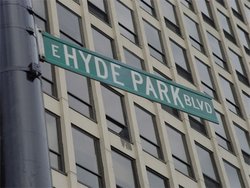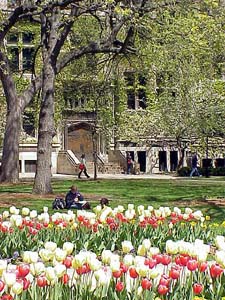Hyde Park, Chicago
|
|
| Missing image Chilkfrnt.jpg Joggers on the lake front | ||
| Community Area 41 - Hyde Park Missing image US-IL-Chicago-CA41.GIF Chicago Community Area 41 - Hyde Park Location within the city of Chicago | ||
| Latitude Longitude | Template:Coor dm | |
| Neighborhoods |
| |
| ZIP Code | parts of 60615, 60637 | |
| Area | 4.27 km² (1.65 mi²) | |
| Population (2000) Density | 29,920 (up 4.51% from 1990) 7,001.3 /km² | |
| Demographics | White Black Hispanic Asian Other | 43.5% 37.7% 4.11% 11.3% 3.39% |
| Median income | $35,991 | |
| Source: U.S. Census, Record Information Services | ||
Hyde Park is a neighborhood on the south side of Chicago, located seven miles south of the Loop; it is home to the Museum of Science and Industry and the University of Chicago.
History of Hyde Park
Hyde Park was founded by real estate speculator Paul Cornell (a first cousin of Ezra Cornell) in the 1850s in what was then unincorporated land south of Chicago.
Although today the term "Hyde Park" is applied to the neighborhood from 47th street to 61st streets, in the 19th century the term applied to areas as far south as the 100s, twelve miles south of the Loop. The narrowing of the term "Hyde Park" was due to the southern sections of old Hyde Park becoming industrial, while the northern sections became genteel. The neighborhood's eastern boundary is Jackson Park, its western boundary is Washington Park
The 1890s marked Hyde Park's emergence as a unique urban neighborhood. In 1892 the University of Chicago opened on land donated by Marshall Field, and 1893 saw the marvelous World's Columbian Exposition in Jackson Park, adjacent to Lake Michigan. The neo-classical World's Columbian Exposition, hugely popular, was the start of the Beaux Arts “City Beautiful" movement. Covering hundreds of acres (a few km²) of palaces and pavilions, the only structure left from the World's Fair is Charles Atgood's Palace of Fine Arts, now the Museum of Science and Industry.
Over the years, Hyde Park grew with Chicago, being annexed in the 1890s. The University of Chicago, through visionary leadership from William Rainey Harper and large sums of money from John D. Rockefeller, quickly became one of the nation's best research institutions. Many of the neighborhood’s stately high rises were actually built as hotels in the 1920s. Famous Hyde Park residents have included Julius Rosenwald, Muhammad Ali, Clarence Darrow, Marshall Field, Mayor Harold Washington, Saul Bellow and numerous other persons associated with the University of Chicago. The neighborhood has produced three U.S. Senators, Paul Douglas, Carol Moseley Braun, and most recently, Barack Obama. Parts of Native Son, the Studs Lonigan trilogy, and The Jungle are set there. The neighborhood contains buildings by Eero Saarinen, Frank Lloyd Wright (the Robie House), L. Mies van der Rohe, and two rises (the University Park Condominiums in the middle of 55th) by I.M. Pei. Most of the University of Chicago main quadrangles were planned and built by Henry Ives Cobb and Charles Coolidge.
Missing image Robie_House.jpg |
In the 1950s and 1960s Hyde Park began to suffer from the economic decline of the rest of the South Side. To protect itself, the University of Chicago sponsored one of the largest urban renewal plans in the nation. Organizing through the Hyde Park-Kenwood Community Conference in ther 1950's, many citizens advocated an "interracial community of high standards." In the 1960s Hyde Park's average income soared by 70%, but its black population fell by 40%. In any case, Hyde Park avoided the fate of slums of neighboring districts like Woodlawn, Washington Park, and Oakland.
The University of Chicago dominates the neighborhood physically and politically. Overall, Hyde Park is one of the most economically vital and desirable neighborhoods in Chicago and an example of racial integration, in a way.
Local Controversies
Thanks to the socioeconomic and educational background of many residents, many Hyde Park residents are politically active within and beyond Hyde Park. Political activities and controversies (of varying levels of importance) in Hyde Park include:
- Debate over urban renewal plans and construction (For a history of the struggle, see Hyde Park-Kenwood Community Conference and the HP Herald special edition.)
- Planned reconstruction of the lakeshore at Promontory Point
- Election campaigns of resident Harold Washington and Senate candidates (cited above)
- University construction and expansion
- Removal of chess tables from Harper Court
- Problems with Hyde Park Coop, a supermarket and member-based cooperative
- Challenges associated with high school students and other local youth
- Local economic development, such as the new Borders bookstore
External links
The Hyde Park Herald (http://www.hpherald.com/)
Hyde Park Historical Society (http://www.hydeparkhistory.org/)
Hyde Park-Kenwood Community Conference (www.hydepark.org)
“At Home in Hyde Park” (Office of Community Affairs, Univ. of Chicago) http://oca.uchicago.edu/hydepark/
Guide designed for students (http://chicagolife.uchicago.edu/city/hydepark.shtml)
Template:Chicago

